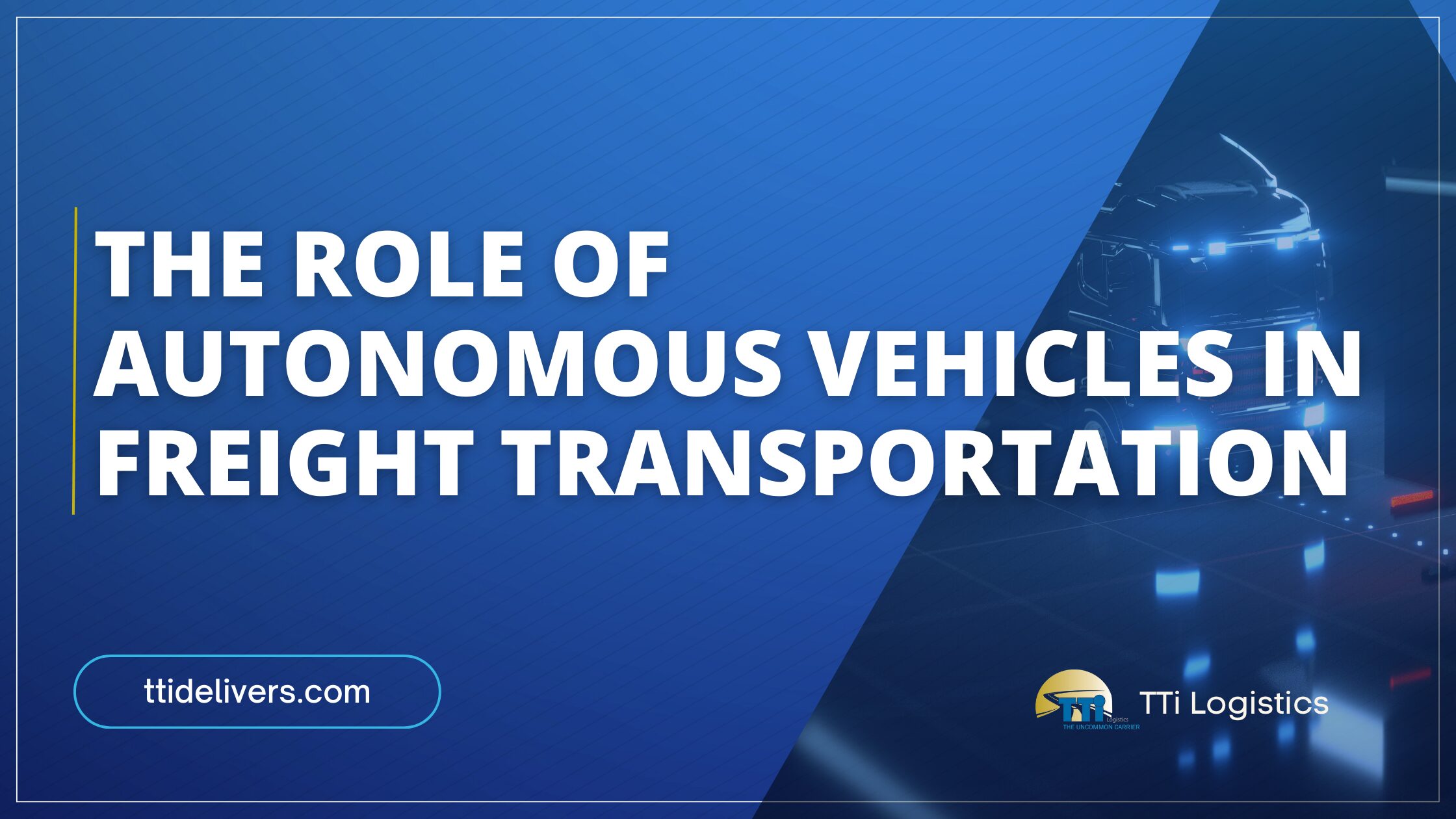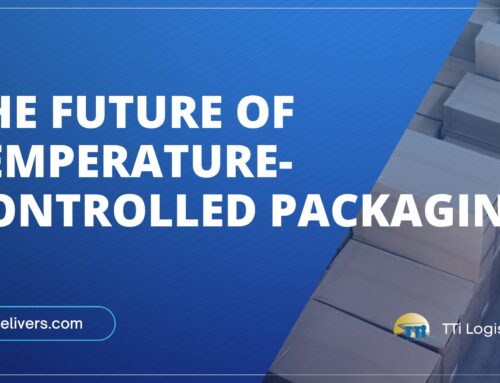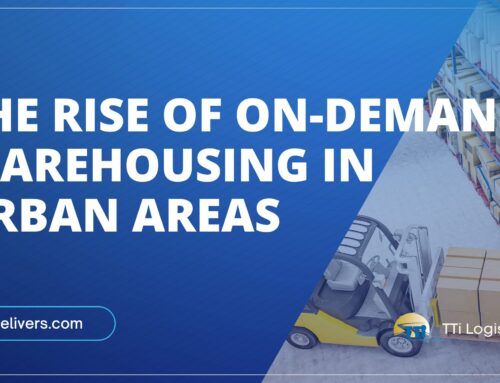How Self-Driving Freight Is Changing the Logistics Industry
Autonomous freight vehicles are no longer just an experimental technology—they’re quickly becoming a transformative force in the logistics industry. As companies seek faster, safer, and more cost-efficient ways to move goods across the country and around the world, autonomous solutions are stepping into the spotlight.
From driverless trucks navigating highways to automated yard vehicles streamlining loading and unloading, the impact of these technologies is reshaping the freight landscape. And as we look ahead to the next several years, businesses are realizing they need to adapt—or risk falling behind.
At TTi Logistics, we’re keeping pace with innovation by exploring how autonomous freight vehicles fit into our overall transportation strategy—improving efficiency while supporting the needs of our clients in a constantly evolving market.
Understanding Autonomous Freight Vehicles: What Are They?
Autonomous freight vehicles refer to trucks, vans, and other cargo-hauling units that are equipped with advanced sensors, software, and control systems to operate with little or no human intervention.
These autonomous vehicles use a combination of:
- Cameras
- Radar and lidar sensors
- GPS navigation
- Artificial intelligence (AI)
- Vehicle-to-infrastructure (V2I) communication
With this blend of tech, they can assess road conditions, detect obstacles, follow traffic laws, and make real-time decisions without a driver behind the wheel.
Types of Autonomous Freight Vehicles
The technology spans a wide range of vehicle types and applications:
- Long-haul driverless trucks: Operating on highways between distribution hubs
- Autonomous last-mile vans: Delivering smaller loads in urban environments
- Self-driving yard trucks: Moving trailers and containers within freight yards or warehouses
- Platooning trucks: A group of semi-autonomous trucks following a lead vehicle in formation
Each serves a unique purpose and plays a role in automating different legs of the supply chain.
Why the Industry Is Turning to Driverless Freight
The logistics and freight industry faces mounting pressure to deliver goods faster, safer, and more reliably. With rising fuel costs, labor shortages, and growing demand for just-in-time delivery, autonomous freight vehicles offer several compelling advantages.
1. Reducing Labor Gaps
Driver shortages are a persistent challenge in freight transport. Autonomous vehicles help bridge the gap by:
- Filling in during off-hours and overnight shifts
- Handling long-haul routes that many drivers avoid
- Reducing the need for multiple drivers per vehicle for cross-country trips
2. Increasing Safety
Autonomous systems don’t get tired, distracted, or impaired. Their sensors can detect hazards and respond faster than human drivers, helping to:
- Prevent accidents
- Maintain safer following distances
- Reduce liability for transportation companies
3. Boosting Efficiency
Self-driving trucks can maintain constant speeds, optimize fuel usage, and avoid unnecessary stops. These efficiencies lead to:
- Lower fuel consumption
- Reduced wear and tear
- Improved on-time delivery performance
4. Supporting Sustainability Goals
By optimizing driving patterns and minimizing idling time, autonomous freight vehicles contribute to more sustainable logistics operations—an increasingly important consideration for modern supply chains.
Major Players and Progress in the Autonomous Freight Space
Many tech startups and traditional vehicle manufacturers are investing in autonomous freight development. Some of the key players pushing innovation include:
- Aurora – Focused on developing autonomous trucks with commercial partners like FedEx and Uber Freight
- TuSimple – Specializing in autonomous semi-trucks with operations in the U.S. and China
- Waymo Via – The freight-focused division of Waymo, developing self-driving transport vehicles
- Embark Trucks – Pioneering autonomous technology for long-haul trucks
- Kodiak Robotics – Partnering with logistics companies to deploy autonomous systems on key shipping lanes
Though full-scale adoption is still a few years away, many of these systems are already in testing or limited use on major freight routes across North America.
Current Limitations of Autonomous Freight Vehicles
While the technology is impressive, autonomous freight vehicles are not without challenges. Understanding these limitations is essential for companies looking to integrate them into their logistics strategy.
Regulatory Hurdles
Different states and countries have varying laws regarding autonomous vehicles. The patchwork nature of these laws can complicate cross-border operations.
Infrastructure Readiness
Autonomous trucks require roads with clear markings, well-maintained surfaces, and compatible infrastructure. Not all highways—or loading docks—are ready for them.
Public Perception and Trust
Many consumers and businesses are still hesitant to fully trust driverless technology, especially when it involves large, heavy vehicles.
Weather Conditions
Autonomous systems still struggle with severe weather, such as heavy snow, fog, or torrential rain, which can limit where and when they can operate safely.
High Development and Implementation Costs
Developing and deploying autonomous systems is expensive. Until costs come down, adoption may remain limited to larger logistics companies and pilot programs.
How TTi Logistics Prepares for an Autonomous Freight Future
At TTi Logistics, we understand that emerging technologies like autonomous freight vehicles aren’t just futuristic concepts—they’re part of the evolving logistics ecosystem. While full-scale implementation may still be a few years out, we’re already laying the groundwork for a more automated, efficient freight network.
Here’s how we’re preparing and adapting our operations:
Exploring Strategic Partnerships
TTi works closely with industry leaders and tech innovators to evaluate autonomous systems that complement our current service model. These partnerships help us stay informed and ready to pilot new solutions as they become viable.
Enhancing Infrastructure Readiness
We’re upgrading our freight yards, warehouse docks, and loading procedures to be compatible with semi-automated vehicles and smart sensors. These upgrades include:
- Improved yard navigation signage
- Digital dock scheduling systems
- Smart gates with sensor-based access control
Investing in Data and AI Systems
Before a fleet can become autonomous, it must become intelligent. We’re investing in fleet tracking, shipment visibility, and AI-driven route planning—all of which support autonomous freight vehicle integration in the near future.
Prioritizing Safety and Compliance
As regulations evolve, we stay ahead of compliance standards. Whether it’s digital logging devices or future autonomous safety certifications, our team is actively monitoring the shifting legal landscape and adapting protocols accordingly.
Practical Use Cases for Businesses Working With TTi Logistics
Whether your company is shipping full truckloads or managing regional distribution, autonomous freight vehicles can offer real benefits when paired with a logistics partner that’s ready to handle the transition.
Here are just a few scenarios where autonomous freight integration—directly or through TTi’s partnerships—can improve results:
Long-Haul Freight Between Distribution Centers
Autonomous trucks are especially useful on long interstate routes. TTi can coordinate shipments using driverless trucks between major hubs, reducing transit times and optimizing fuel use.
After-Hours or Overnight Delivery Windows
With 24/7 capabilities, autonomous freight vehicles allow TTi to schedule more flexible pickups and deliveries, including overnight windows that would otherwise require costly overtime staffing.
Time-Sensitive Freight
Autonomous freight vehicles minimize delays caused by fatigue-related rest stops, shift changes, or human error. This results in faster, more reliable delivery for time-sensitive goods like medical supplies or perishable items.
High-Risk or Repetitive Routes
For routes that are physically taxing or carry a higher risk of accidents, autonomous vehicles can reduce exposure for human drivers while maintaining service consistency.
What to Expect From Autonomous Freight in the Next 5 Years
The pace of innovation in this space is accelerating quickly. While a fully autonomous freight system won’t happen overnight, significant changes are coming. Here’s what businesses can expect to see through 2030:
Broader Testing and Regional Deployment
Expect to see autonomous freight vehicles deployed in more regions as infrastructure improves and regulatory frameworks evolve. Pilot programs will expand across major freight corridors.
Blended Human-Autonomous Operations
Rather than full replacement, most fleets will adopt a hybrid model. Human drivers will handle urban, complex deliveries, while autonomous systems take care of predictable highway routes.
Freight-as-a-Service Platforms
As automation increases, we’ll see more platform-based freight models emerge, where businesses can schedule, track, and manage shipments using real-time AI and autonomous assets.
Specialized Use Cases Will Lead the Way
High-volume, repeatable freight routes with consistent infrastructure will be the first to adopt autonomous tech at scale. Over time, more complex logistics needs will follow.
Policy Standardization Will Open Doors
Once national regulations catch up to the technology, adoption will accelerate. Federal policy support will be crucial in creating a unified framework for safe and efficient autonomous freight movement.
How to Prepare Your Business for Autonomous Logistics
As autonomous freight vehicles become more common, the businesses that benefit most will be those that start preparing now.
Here are a few simple steps to get ready:
1. Digitize Your Freight Operations
If your logistics systems still rely heavily on paper processes, now’s the time to switch to digital. Cloud-based shipment tracking, digital BOLs, and smart warehouse management systems are essential building blocks.
2. Evaluate Your Route Structures
Start looking at your most predictable and high-volume lanes. These are the ideal candidates for early autonomous freight adoption through partnerships like TTi’s.
3. Educate Your Team
From logistics managers to warehouse teams, everyone should understand the basics of autonomous freight and how it may affect operations. Training and transparency now will prevent resistance later.
4. Stay Informed on Regulations
Monitor developments from agencies like the FMCSA and NHTSA. TTi also provides regulatory updates to clients, helping you stay compliant and forward-thinking.
5. Partner with an Innovation-Forward Logistics Provider
Working with a provider like TTi Logistics means you don’t have to navigate these changes alone. We evaluate, test, and implement emerging tech—so you can focus on running your business.
Looking Ahead: Efficiency Without Compromise
Autonomous freight vehicles aren’t just a novel concept—they’re a strategic tool for solving real logistics challenges. From improving delivery speed and lowering costs to enhancing safety and meeting sustainability goals, autonomous technology has the potential to revolutionize how goods move across the globe.
But the transition won’t happen in isolation. It requires collaboration between shippers, carriers, regulators, and logistics experts.
At TTi Logistics, we’re taking steps today to ensure we’re ready for the future of autonomous transportation—and that our clients are, too.







